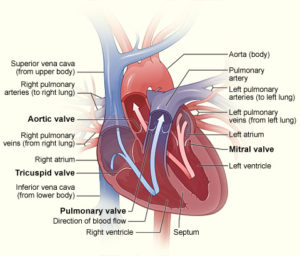By Ross Echols; Farnsley Middle School (Louisville, KY)
In the summer of 1988, my father, Darrel Echols was rushed to the hospital due to chest pains. In an interview, he said, “My chest felt tight and I was a little short of breath.” He was later diagnosed with mitral valve prolapse. At the time, he was 19.
According to WebMD and the American Heart Association, mitral valve prolapse (MVP) is when the mitral valve leaflets bend backwards into the left atrium as the left ventricle contracts. So think of the mitral valve as a gate between two parts of your heart. Blood goes through the valve. Normally, the blood flows through one way and doesn’t go

back the other way. A “leaky” mitral valve means that blood can go back through he mitral valve, known as mitral regurgitation.
According to the American Heart Association, MVP can occur due to being born with a genetic risk of developing into MVP, having abnormally stretchy mitral valve leaflets, or some connective tissue disorders. Mitral valve prolapse isn’t very common, it only occurs in seven percent of the population, mostly women, and it is known to run in families. Serious symptoms tend to occur in men older than age fifty.
According to the Mayo Clinic, doctors may use an echocardiogram (ECG), a stress test, or a coronary angiogram to diagnose MVP. An echocardiogram is machine that has probes that are placed on the chest to record the impulses that cause the heart to beat. A stress test is where a doctor has a patient exercise or take medications to increase heart rate to check for mitral regurgitation. Mitral regurgitation is when the heart pumps blood from the left atrium through the mitral valve into the left ventricle, some of the blood leaks back into the left atrium. Atriums and ventricles are basically four sections of the heart. There are also the right atrium and ventricle, and separating them is the tricuspid valve. Cardiologists can also use x-rays of the chest to diagnose mitral valve prolapse. Echols was diagnosed using an ECG, ultrasound of the heart, and a heart monitor.
Dr. Wayne Gibson, a professor of cardiology who works in Jeffersonville, IN stated in an office visit with Echols that symptoms include shortness of breath, chest pain, and skipped and extra heartbeats. He also said that there is a treatment known as a beta blocker that can slow one’s heart rate and prevent extra beats. Most medications for mitral valve prolapse only treat the symptoms, as do beta blockers. Ninety percent of people diagnosed with mitral valve prolapse will not need surgery to correct it. If needed, surgeons can implant an artificial valve. “I suffer from chest pains, shortness of breath, and accelerated heart rate,” Echols says.
According to MVP Resource, most people with MVP should avoid food and drink with caffeine and other stimulants (i.e. coffee, tea, chocolate, etc) because it stimulates the autonomic nervous system (ANS), causing it to become unstable. “When the ANS becomes unstable, body functions slow down or speed up inappropriately. This can have a significant effect on MVP symptoms.” MVP Resource also says you should avoid sweets/candy, soft drinks, alcohol, and fruit juice. Echols avoids pretty much anything with caffeine.
Echols is doing fine now. He states, “Even though I’ll probably have mitral valve prolapse for the rest of my life, I won’t let it get in the way of spending time with my wife and kids.”

This work is licensed under a Creative Commons Attribution-NonCommercial-NoDerivs 3.0 Unported License.














